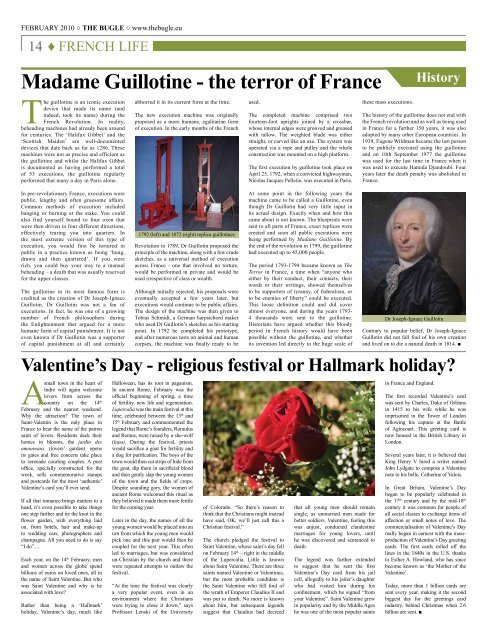Creuse is still the safest place to live in France - The Bugle
Creuse is still the safest place to live in France - The Bugle
Creuse is still the safest place to live in France - The Bugle
You also want an ePaper? Increase the reach of your titles
YUMPU automatically turns print PDFs into web optimized ePapers that Google loves.
FEBRUARY 2010 ○ THE BUGLE ○ www.<strong>the</strong>bugle.eu<br />
14 ♦ FRENCH LIFE<br />
Madame Guillot<strong>in</strong>e - <strong>the</strong> terror of <strong>France</strong><br />
H<strong>is</strong><strong>to</strong>ry<br />
<strong>The</strong> guillot<strong>in</strong>e <strong>is</strong> an iconic execution<br />
device that made its name (and<br />
<strong>in</strong>deed, <strong>to</strong>ok its name) dur<strong>in</strong>g <strong>the</strong><br />
French Revolution. In reality,<br />
behead<strong>in</strong>g mach<strong>in</strong>es had already been around<br />
for centuries. <strong>The</strong> ‘Halifax Gibbet’ and <strong>the</strong><br />
‘Scott<strong>is</strong>h Maiden’ are well-documented<br />
devices that date back as far as 1286. <strong>The</strong>se<br />
mach<strong>in</strong>es were not as prec<strong>is</strong>e and efficient as<br />
<strong>the</strong> guillot<strong>in</strong>e and whilst <strong>the</strong> Halifax Gibbet<br />
<strong>is</strong> documented as hav<strong>in</strong>g performed a <strong>to</strong>tal<br />
of 53 executions, <strong>the</strong> guillot<strong>in</strong>e regularly<br />
performed that many a day <strong>in</strong> Par<strong>is</strong> alone.<br />
abhorred it <strong>in</strong> its current form at <strong>the</strong> time.<br />
<strong>The</strong> new execution mach<strong>in</strong>e was orig<strong>in</strong>ally<br />
proposed as a more humane, egalitarian form<br />
of execution. In <strong>the</strong> early months of <strong>the</strong> French<br />
used.<br />
<strong>The</strong> completed mach<strong>in</strong>e compr<strong>is</strong>ed two<br />
fourteen-foot uprights jo<strong>in</strong>ed by a crossbar,<br />
whose <strong>in</strong>ternal edges were grooved and greased<br />
with tallow. <strong>The</strong> weighted blade was ei<strong>the</strong>r<br />
straight, or curved like an axe. <strong>The</strong> system was<br />
operated via a rope and pulley and <strong>the</strong> whole<br />
construction was mounted on a high platform.<br />
<strong>The</strong> first execution by guillot<strong>in</strong>e <strong>to</strong>ok <strong>place</strong> on<br />
April 25, 1792, when a convicted highwayman,<br />
Nicolas Jacques Pelletie, was executed <strong>in</strong> Par<strong>is</strong>.<br />
<strong>the</strong>se mass executions.<br />
<strong>The</strong> h<strong>is</strong><strong>to</strong>ry of <strong>the</strong> guillot<strong>in</strong>e does not end with<br />
<strong>the</strong> French revolution and as well as be<strong>in</strong>g used<br />
<strong>in</strong> <strong>France</strong> for a fur<strong>the</strong>r 150 years, it was also<br />
adopted by many o<strong>the</strong>r European countries. In<br />
1939, Eugene Wildman became <strong>the</strong> last person<br />
<strong>to</strong> be publicly executed us<strong>in</strong>g <strong>the</strong> guillot<strong>in</strong>e<br />
and on 10th September 1977 <strong>the</strong> guillot<strong>in</strong>e<br />
was used for <strong>the</strong> last time <strong>in</strong> <strong>France</strong> when it<br />
was used <strong>to</strong> execute Hamida Djandoubi. Four<br />
years later <strong>the</strong> death penalty was abol<strong>is</strong>hed <strong>in</strong><br />
<strong>France</strong>.<br />
In pre-revolutionary <strong>France</strong>, executions were<br />
public, lengthy and often gruesome affairs.<br />
Common methods of execution <strong>in</strong>cluded<br />
hang<strong>in</strong>g or burn<strong>in</strong>g at <strong>the</strong> stake. You could<br />
also f<strong>in</strong>d yourself bound <strong>to</strong> four oxen that<br />
were <strong>the</strong>n driven <strong>in</strong> four different directions,<br />
effectively tear<strong>in</strong>g you <strong>in</strong><strong>to</strong> quarters. In<br />
<strong>the</strong> most extreme version of th<strong>is</strong> type of<br />
execution, you would first be <strong>to</strong>rtured <strong>in</strong><br />
public <strong>in</strong> a practice known as be<strong>in</strong>g ‘hung,<br />
drawn and <strong>the</strong>n quartered’. If you were<br />
rich, you could buy your way <strong>to</strong> a manual<br />
behead<strong>in</strong>g – a death that was usually reserved<br />
for <strong>the</strong> upper classes.<br />
<strong>The</strong> guillot<strong>in</strong>e <strong>in</strong> its most famous form <strong>is</strong><br />
credited as <strong>the</strong> creation of Dr Joseph-Ignace<br />
Guillot<strong>in</strong>. Dr Guillot<strong>in</strong> was not a fan of<br />
executions. In fact, he was one of a grow<strong>in</strong>g<br />
number of French philosophers dur<strong>in</strong>g<br />
<strong>the</strong> Enlightenment that argued for a more<br />
humane form of capital pun<strong>is</strong>hment. It <strong>is</strong> not<br />
even known if Dr Guillot<strong>in</strong> was a supporter<br />
of capital pun<strong>is</strong>hment at all and certa<strong>in</strong>ly<br />
1792 (left) and 1872 (right) replica guillot<strong>in</strong>es<br />
Revolution <strong>in</strong> 1789, Dr Guillot<strong>in</strong> proposed <strong>the</strong><br />
pr<strong>in</strong>ciple of <strong>the</strong> mach<strong>in</strong>e, along with a few crude<br />
sketches, as a universal method of execution<br />
across <strong>France</strong> - one that <strong>in</strong>volved no <strong>to</strong>rture,<br />
would be performed <strong>in</strong> private and would be<br />
used irrespective of class or wealth.<br />
Although <strong>in</strong>itially rejected, h<strong>is</strong> proposals were<br />
eventually accepted a few years later, but<br />
executions would cont<strong>in</strong>ue <strong>to</strong> be public affairs.<br />
<strong>The</strong> design of <strong>the</strong> mach<strong>in</strong>e was <strong>the</strong>n given <strong>to</strong><br />
Tobias Schmidt, a German harpsichord maker<br />
who used Dr Guillot<strong>in</strong>’s sketches as h<strong>is</strong> start<strong>in</strong>g<br />
po<strong>in</strong>t. In 1792 he completed h<strong>is</strong> pro<strong>to</strong>type,<br />
and after numerous tests on animal and human<br />
corpses, <strong>the</strong> mach<strong>in</strong>e was f<strong>in</strong>ally ready <strong>to</strong> be<br />
At some po<strong>in</strong>t <strong>in</strong> <strong>the</strong> follow<strong>in</strong>g years <strong>the</strong><br />
mach<strong>in</strong>e came <strong>to</strong> be called a Guillot<strong>in</strong>e, even<br />
though Dr Guillot<strong>in</strong> had very little <strong>in</strong>put <strong>in</strong><br />
its actual design. Exactly when and how th<strong>is</strong><br />
came about <strong>is</strong> not known. <strong>The</strong> bluepr<strong>in</strong>ts were<br />
sent <strong>to</strong> all parts of <strong>France</strong>, exact replicas were<br />
created and soon all public executions were<br />
be<strong>in</strong>g performed by Madame Guillot<strong>in</strong>e. By<br />
<strong>the</strong> end of <strong>the</strong> revolution <strong>in</strong> 1799, <strong>the</strong> guillot<strong>in</strong>e<br />
had executed up <strong>to</strong> 45,000 people.<br />
<strong>The</strong> period 1793-1794 became known as <strong>The</strong><br />
Terror <strong>in</strong> <strong>France</strong>, a time when “anyone who<br />
ei<strong>the</strong>r by <strong>the</strong>ir conduct, <strong>the</strong>ir contacts, <strong>the</strong>ir<br />
words or <strong>the</strong>ir writ<strong>in</strong>gs, showed <strong>the</strong>mselves<br />
<strong>to</strong> be supporters of tyranny, of federal<strong>is</strong>m, or<br />
<strong>to</strong> be enemies of liberty” could be executed.<br />
Th<strong>is</strong> loose def<strong>in</strong>ition could and did cover<br />
almost everyone, and dur<strong>in</strong>g <strong>the</strong> years 1793-<br />
4 thousands were sent <strong>to</strong> <strong>the</strong> guillot<strong>in</strong>e.<br />
H<strong>is</strong><strong>to</strong>rians have argued whe<strong>the</strong>r th<strong>is</strong> bloody<br />
period <strong>in</strong> French h<strong>is</strong><strong>to</strong>ry would have been<br />
possible without <strong>the</strong> guillot<strong>in</strong>e, and whe<strong>the</strong>r<br />
its <strong>in</strong>vention led directly <strong>to</strong> <strong>the</strong> huge scale of<br />
Dr Joseph-Ignace Guillot<strong>in</strong><br />
Contrary <strong>to</strong> popular belief, Dr Joseph-Ignace<br />
Guillot<strong>in</strong> did not fall foul of h<strong>is</strong> own creation<br />
and <strong>live</strong>d on <strong>to</strong> die a natural death <strong>in</strong> 1814. ■<br />
Valent<strong>in</strong>e’s Day - religious festival or Hallmark holiday<br />
A<br />
<strong>in</strong> <strong>France</strong> and England.<br />
small <strong>to</strong>wn <strong>in</strong> <strong>the</strong> heart of<br />
Indre will aga<strong>in</strong> welcome<br />
lovers from across <strong>the</strong><br />
country on <strong>the</strong> 14 th<br />
February and <strong>the</strong> nearest weekend.<br />
Why <strong>the</strong> attraction <strong>The</strong> <strong>to</strong>wn of<br />
Sa<strong>in</strong>t-Valent<strong>in</strong> <strong>is</strong> <strong>the</strong> only <strong>place</strong> <strong>in</strong><br />
<strong>France</strong> <strong>to</strong> bear <strong>the</strong> name of <strong>the</strong> patron<br />
sa<strong>in</strong>t of lovers. Residents deck <strong>the</strong>ir<br />
homes <strong>in</strong> blooms, <strong>the</strong> jard<strong>in</strong> des<br />
amoureaux (lovers’ garden) opens<br />
its gates and free concerts take <strong>place</strong><br />
<strong>to</strong> serenade court<strong>in</strong>g couples. A post<br />
office, specially constructed for <strong>the</strong><br />
week, sells commemorative stamps<br />
and postcards for <strong>the</strong> most ‘au<strong>the</strong>ntic’<br />
Valent<strong>in</strong>e’s card you’ll ever send.<br />
If all that romance br<strong>in</strong>gs matters <strong>to</strong> a<br />
head, it’s even possible <strong>to</strong> take th<strong>in</strong>gs<br />
one step fur<strong>the</strong>r and tie <strong>the</strong> knot <strong>in</strong> <strong>the</strong><br />
flower garden, with everyth<strong>in</strong>g laid<br />
on, from hotels, hair and make-up<br />
<strong>to</strong> wedd<strong>in</strong>g cars, pho<strong>to</strong>graphers and<br />
champagne. All you need <strong>to</strong> do <strong>is</strong> say<br />
“I do”....<br />
Each year, on <strong>the</strong> 14 th February, men<br />
and women across <strong>the</strong> globe spend<br />
billions of euros on loved ones, all <strong>in</strong><br />
<strong>the</strong> name of Sa<strong>in</strong>t Valent<strong>in</strong>e. But who<br />
was Sa<strong>in</strong>t Valent<strong>in</strong>e and why <strong>is</strong> he<br />
associated with love<br />
Ra<strong>the</strong>r than be<strong>in</strong>g a ‘Hallmark’<br />
holiday, Valent<strong>in</strong>e’s day, much like<br />
Halloween, has its root <strong>in</strong> pagan<strong>is</strong>m.<br />
In ancient Rome, February was <strong>the</strong><br />
official beg<strong>in</strong>n<strong>in</strong>g of spr<strong>in</strong>g, a time<br />
of fertility, new life and regeneration.<br />
Lupercalia was <strong>the</strong> ma<strong>in</strong> festival at th<strong>is</strong><br />
time, celebrated between <strong>the</strong> 13 th and<br />
15 th February and commemorated <strong>the</strong><br />
legend that Rome’s founders, Romulus<br />
and Remus, were ra<strong>is</strong>ed by a she-wolf<br />
(lupa). Dur<strong>in</strong>g <strong>the</strong> festival, priests<br />
would sacrifice a goat for fertility and<br />
a dog for purification. <strong>The</strong> boys of <strong>the</strong><br />
<strong>to</strong>wn would <strong>the</strong>n cut strips of hide from<br />
<strong>the</strong> goat, dip <strong>the</strong>m <strong>in</strong> sacrificial blood<br />
and <strong>the</strong>n gently slap <strong>the</strong> young women<br />
of <strong>the</strong> <strong>to</strong>wn and <strong>the</strong> fields of crops.<br />
Despite sound<strong>in</strong>g gory, <strong>the</strong> women of<br />
ancient Rome welcomed th<strong>is</strong> ritual as<br />
<strong>the</strong>y believed it made <strong>the</strong>m more fertile<br />
for <strong>the</strong> com<strong>in</strong>g year.<br />
Later <strong>in</strong> <strong>the</strong> day, <strong>the</strong> names of all <strong>the</strong><br />
young women would be <strong>place</strong>d <strong>in</strong><strong>to</strong> an<br />
urn from which <strong>the</strong> young men would<br />
pick one and th<strong>is</strong> pair would <strong>the</strong>n be<br />
coupled for <strong>the</strong> next year. Th<strong>is</strong> often<br />
led <strong>to</strong> marriages, but was considered<br />
un-Chr<strong>is</strong>tian by <strong>the</strong> church and <strong>the</strong>re<br />
were repeated attempts <strong>to</strong> outlaw <strong>the</strong><br />
festival.<br />
“At <strong>the</strong> time <strong>the</strong> festival was clearly<br />
a very popular event, even <strong>in</strong> an<br />
environment where <strong>the</strong> Chr<strong>is</strong>tians<br />
were try<strong>in</strong>g <strong>to</strong> close it down,” says<br />
Professor Lenski of <strong>the</strong> University<br />
of Colorado. “So <strong>the</strong>re’s reason <strong>to</strong><br />
th<strong>in</strong>k that <strong>the</strong> Chr<strong>is</strong>tians might <strong>in</strong>stead<br />
have said, OK, we’ll just call th<strong>is</strong> a<br />
Chr<strong>is</strong>tian festival.”<br />
<strong>The</strong> church pledged <strong>the</strong> festival <strong>to</strong><br />
Sa<strong>in</strong>t Valent<strong>in</strong>e, whose sa<strong>in</strong>t’s day fell<br />
on February 14 th – right <strong>in</strong> <strong>the</strong> middle<br />
of <strong>the</strong> Lupercalia. Little <strong>is</strong> known<br />
about Sa<strong>in</strong>t Valent<strong>in</strong>e. <strong>The</strong>re are three<br />
sa<strong>in</strong>ts named Valent<strong>in</strong>e or Valent<strong>in</strong>us,<br />
but <strong>the</strong> most probable candidate <strong>is</strong><br />
<strong>the</strong> Sa<strong>in</strong>t Valent<strong>in</strong>e who fell foul of<br />
<strong>the</strong> wrath of Emperor Claudius II and<br />
was put <strong>to</strong> death. No more <strong>is</strong> known<br />
about him, but subsequent legends<br />
suggest that Claudius had decreed<br />
that all young men should rema<strong>in</strong><br />
s<strong>in</strong>gle, as unmarried men made for<br />
better soldiers. Valent<strong>in</strong>e, feel<strong>in</strong>g th<strong>is</strong><br />
was unjust, conducted clandest<strong>in</strong>e<br />
marriages for young lovers, until<br />
he was d<strong>is</strong>covered and sentenced <strong>to</strong><br />
death.<br />
<strong>The</strong> legend was fur<strong>the</strong>r extended<br />
<strong>to</strong> suggest that he sent <strong>the</strong> first<br />
Valent<strong>in</strong>e’s Day card from h<strong>is</strong> jail<br />
cell, allegedly <strong>to</strong> h<strong>is</strong> jailer’s daughter<br />
who had v<strong>is</strong>ited him dur<strong>in</strong>g h<strong>is</strong><br />
conf<strong>in</strong>ement, which he signed “from<br />
your Valent<strong>in</strong>e”. Sa<strong>in</strong>t Valent<strong>in</strong>e grew<br />
<strong>in</strong> popularity and by <strong>the</strong> Middle Ages<br />
he was one of <strong>the</strong> most popular sa<strong>in</strong>ts<br />
<strong>The</strong> first recorded Valent<strong>in</strong>e’s card<br />
was sent by Charles, Duke of Orléans<br />
<strong>in</strong> 1415 <strong>to</strong> h<strong>is</strong> wife while he was<br />
impr<strong>is</strong>oned <strong>in</strong> <strong>the</strong> Tower of London<br />
follow<strong>in</strong>g h<strong>is</strong> capture at <strong>the</strong> Battle<br />
of Ag<strong>in</strong>court. Th<strong>is</strong> greet<strong>in</strong>g card <strong>is</strong><br />
now housed <strong>in</strong> <strong>the</strong> Brit<strong>is</strong>h Library <strong>in</strong><br />
London.<br />
Several years later, it <strong>is</strong> believed that<br />
K<strong>in</strong>g Henry V hired a writer named<br />
John Lydgate <strong>to</strong> compose a Valent<strong>in</strong>e<br />
note <strong>to</strong> h<strong>is</strong> belle, Ca<strong>the</strong>r<strong>in</strong>e of Valo<strong>is</strong>.<br />
In Great Brita<strong>in</strong>, Valent<strong>in</strong>e’s Day<br />
began <strong>to</strong> be popularly celebrated <strong>in</strong><br />
<strong>the</strong> 17 th century and by <strong>the</strong> mid-18 th<br />
century it was common for people of<br />
all social classes <strong>to</strong> exchange items of<br />
affection or small notes of love. <strong>The</strong><br />
commercial<strong>is</strong>ation of Valent<strong>in</strong>e’s Day<br />
really began <strong>in</strong> earnest with <strong>the</strong> massproduction<br />
of Valent<strong>in</strong>e’s Day greet<strong>in</strong>g<br />
cards. <strong>The</strong> first cards rolled off <strong>the</strong><br />
l<strong>in</strong>es <strong>in</strong> <strong>the</strong> 1840s <strong>in</strong> <strong>the</strong> U.S. thanks<br />
<strong>to</strong> Es<strong>the</strong>r A. Howland, who has s<strong>in</strong>ce<br />
become known as ‘<strong>the</strong> Mo<strong>the</strong>r of <strong>the</strong><br />
Valent<strong>in</strong>e’.<br />
Today, more than 1 billion cards are<br />
sent every year, mak<strong>in</strong>g it <strong>the</strong> second<br />
biggest day for <strong>the</strong> greet<strong>in</strong>gs card<br />
<strong>in</strong>dustry, beh<strong>in</strong>d Chr<strong>is</strong>tmas when 2.6<br />
billion are sent. ■
















